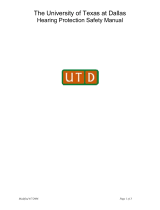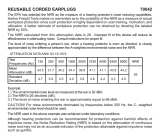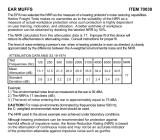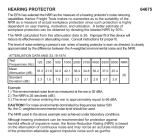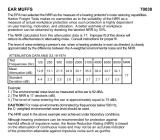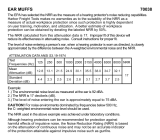
E-A-R 00-28/HP Page - 15
24. Muller, H. G. and Killion, M. C. (1990). “An Easy Method for Calculating the Articulation Index,” Hearing J. 43(9), 14-
17.
25. Lipscomb, D. M. (1988). "The Employee Education Program," in Hearing Conservation in Industry, Schools, and the
Military, edited by D. M. Lipscomb, College-Hill Press, Boston, MA, 193-202.
26. Lofgreen, H., Holm, M., and Tengling, R. (1982). "How to Motivate People in the Use of Their Hearing Protectors," in
Personal Hearing Protection in Industry, edited by P. W. Alberti, Raven Press, New York, NY, 485-490.
27. Lusk, S. L. (1999). "Translating Research into Training: Motivating Construction Workers to Use Hearing Protection
Devices," Spectrum Suppl. 1, 16, p. 21.
28. Lusk, S. L., Ronis, D. L., Kerr, M. J., and Atwood, J. R. (1994). "Test of the Health Promotion Model as a Causal
Model of Workers' Use of Hearing Protection," Nurs. Res. 43(3), 151-157.
29. Luz, G. A., Decatur, R. A., and Thompson, R. L. (1973). "Psychological Factors Related to the Voluntary Use of
Hearing Protection in Hazardous Noise Environments," U.S. Army Med. Res. Laboratory Report No. AD-777 520,
Fort Knox, KY.
30. Maas, R. B. (1970). "The Challenge of Hearing Protection," Ind. Med. 39(3), 29-33.
31. Maas, R. B. (1972). "Industrial Noise and Hearing Conservation," in Handbook of Clinical Audiology, edited by J.
Katz, Williams and Wilkins Co., Baltimore, MD, 772-818.
32. Meinke, D. (2000). Personal communication.
33. Meinke, D. and Hackel, S. (2000). "Hearing Loss Prevention as Part of a Wellness Program," Spectrum Suppl. 1, 17,
p. 22.
34. Merry, C. J. (1995). "Instilling a Safety Culture in the Workplace," in Proceedings Hearing Conservation Conference
III/XX, edited by J. Franks and J. Casali, Natl. Hearing Conservation Assoc., Des Moines, IA, 86-92.
35. Merry, C. J. and Franks, J. R. (1995). "Historical Assessment and Future Directions in the Prevention of Occupational
Hearing Loss," in Occupational Medicine: State of the Art Reviews - Vol. 10, No. 3, edited by T. C. Morata and D. E.
Dunn, Hanley & Belfus, Inc., Philadelphia, PA, 669-681.
36. Merry, C. J. and Stephenson, M. R. (1999). "Reliability and Feasibility of Earplug Fit-Testing in the Real World,"
Spectrum Suppl. 1, 16, p. 21.
37. Michael, K. (1999). "Measurement of Insert-Type Hearing Protector Attenuation on the End-User: A Practical
Alternative to Relying on the NRR," Spectrum 16(4), 13-17.
38. Nelson, D. A. and Cooper, B. A. (1998). "Auditory Demonstrations in Acoustics and Hearing Conservation," in
Proceedings of Noise-Con 98, edited by J. S. Bolton and L. Mongeau, Noise Control Foundation, Poughkeepsie, NY,
45-48.
39. Niswender, M. E. (1980). "Making Good 'Cents' Out of Hearing Conservation," Occup. Health Saf., March, 57-60.
40. Ohlin, D. (2000a). Personal communication re examples in military pamphlets.
41. Ohlin, D. (2000b). "Behavioral Obstacles to Marketing Hearing Conservation Programs," Spectrum Suppl. 1, 17, p.
17.
42. Petrakis, N. L. (2000). "Earmarks of Art History: Cerumen and Medieval Art," Am. J. Otol. 21(1), 5-8.
43. Royster, J. D. (2000). “Audiometric Monitoring Phase of the HCP,” in The Noise Manual, 5
th
Edition, edited by E. H.
Berger, L. H. Royster, J. D. Royster, D. P. Driscoll, and M. Layne, Am. Ind. Hyg. Assoc., Fairfax, VA, 455-516.
44. Royster, L. H. and Royster, J. D. (2000). "Education and Motivation," in The Noise Manual, 5
th
Edition, edited by E. H.
Berger, L. H. Royster, J. D. Royster, D. P. Driscoll, and M. Layne, Am. Ind. Hyg. Assoc., Fairfax, VA, 245-278.
45. Sadler, O. W. and Montgomery, G. M. (1982). "The Application of Positive Practice Overcorrection to the Use of
Hearing Protection," Am. Ind. Hyg. Assoc. J. 43(6), 451-454.
46. Schaefer, M. R. (1992). A Sound Education, 100 Exercises in Listening and Sound-Making, Arcana Editions, Indian
River, Canada.
47. Schafer, R. M. (1993). Voices of Tyranny, Temples of Silence, Arcana Editions, Ontario, Canada.


















